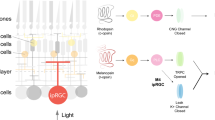Abstract
DURING the past few years a great deal of work has been done on the physiology of crustacean limb proprioceptors. The study reported here involved ultrastructural differences between functionally distinct cells in the propodite–dactylopodite (PD) chordotonal organ of Cancer pagurus, and was based on serial transverse sections. Final details will be published elsewhere.
Similar content being viewed by others
References
Wiersma, C. A. G., J. Marine Biol. Assoc. UK, 38, 143 (1959).
Wiersma, C. A. G., and Boettiger, E. G., J. Exp. Biol., 36, 102 (1959).
Hartman, H. B., and Boettiger, E. G., Comp. Biochem. Physiol., 22, 651 (1967).
Whitear, M., Nature, 187, 522 (1960).
Whitear, M., Phil. Trans. Roy. Soc., B., 245, 291 (1962).
Mendelson, M., J. Exp. Biol., 40, 157 (1963).
Bush, B. M. H., Comp. Biochem. Physiol., 14, 185 (1965).
Bush, B. M. H., J. Exp. Biol., 42, 285 (1965).
Author information
Authors and Affiliations
Rights and permissions
About this article
Cite this article
MILL, P., LOWE, D. Transduction Processes of Movement and Position Sensitive Cells in a Crustacean Limb Proprioceptor. Nature 229, 206–208 (1971). https://doi.org/10.1038/229206a0
Received:
Issue Date:
DOI: https://doi.org/10.1038/229206a0
- Springer Nature Limited
This article is cited by
-
Antennal proprioception in the rock lobsterPalinurus vulgaris: Anatomy and physiology of a bi-articular chordotonal organ
Journal of Comparative Physiology ? A (1982)
-
The formation of the epicuticle and associated structures inOniscus asellus (Crustacea, Isopoda)
Zoomorphologie (1980)
-
Sensory and reflex physiology underlying cheliped flexion behavior in hermit crabs
Journal of Comparative Physiology (1974)
-
Mechanorezeptoren im Insektentarsus
Zeitschrift f�r Morphologie der Tiere (1974)
-
Erster Nachweis von Scolopalorganen in den Gliederantennen eines entognathen Insekts (Collembola, Symphypleona)
Zeitschrift f�r Morphologie der Tiere (1974)





